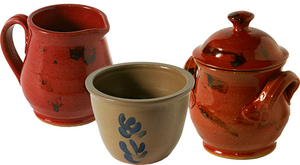

Tim Frain of Greene County, Tenn., adapted the cachepot, center, from a late 19th century storage vessel made by J.B. Magee in Washington County, Va. Frain adapted the covered sugar bowl, right, from an earthenware honey pot and the creamer, left, from an earthenware pitcher — both from Washington County, Va. (Photography by Jeffrey Stoner)
Heritage Products of Southwest Virginia and Northeast Tennessee are faithful reproductions and adaptations of the craft legacy of the rolling hills and mountains of this southern Appalachian region. They are available at The Looking Glass gift shop at the William King Museum, Abingdon, Va. Based on more than 10 years of research by William King's Cultural Heritage Project, these products are representative of more than 2,000 documented objects, including furniture, textiles, woodworking, metalsmithing, pottery, and baskets.
In 2005, the museum asked Tim Frain from Greene County, Tenn., to handcraft reproductions of historic regional pottery. Frain, former electrical engineer, architect, and time-study analyst, has no formal art education, yet he is an accomplished potter, photographer, painter, silk screener and papermaker. Most of his pottery is designed with a chef in mind. Frain cooks with his new designs before making them available to the public.
In reproducing a cachepot by J.A. Magee, Frain used durable, speckled brownstone clay. He discovered that the original flower design had been finger-painted, so he used the same technique to create this piece. Frain even reproduced the Magee stamp near the rim. He interpreted the vessel in two sizes, one a faithful reproduction and the other approximately half the size of the historic piece.
Frain adapted a covered sugar bowl from an earthenware honey pot and a creamer from an earthenware pitcher - both from Washington County, Va., circa 1840. The bulbous shape and pulled handles on the bowl are familiar characteristics of historic regional pottery. Local iron-rich clay with lead glazing produced a rich orange color. Both pieces feature distinctive manganese-oxide daubed decoration under a lead glaze.
READ ON: